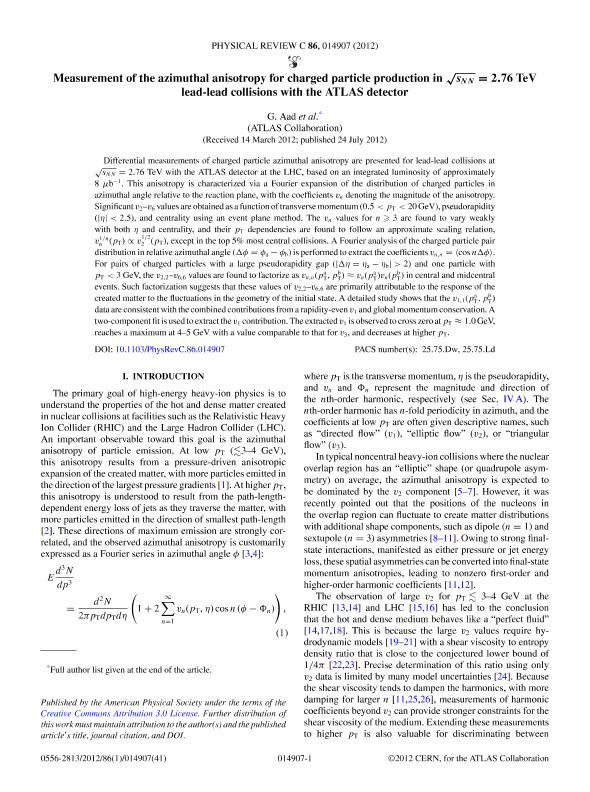Artículo
Measurement of the azimuthal anisotropy for charged particle production in √sNN = 2.76 TeV lead-lead collisions with the ATLAS detector
Aad, G.; Abbott, B.; Abdallah, J.; Abdel Khalek, S.; Abdelalim, A. A.; González Silva, María Laura ; Otero y Garzon, Gustavo Javier
; Otero y Garzon, Gustavo Javier ; Piegaia, Ricardo Nestor
; Piegaia, Ricardo Nestor ; Romeo, Gaston Leonardo
; Romeo, Gaston Leonardo ; Anduaga, Xabier Sebastian
; Anduaga, Xabier Sebastian ; Dova, Maria Teresa
; Dova, Maria Teresa ; Monticelli, Fernando Gabriel
; Monticelli, Fernando Gabriel ; Tripiana, Martin Fernando
; Tripiana, Martin Fernando ; Zhu, Y.; Zhuang, X.; Zhuravlov, V.; Zieminska, D.; Zimmermann, R.; Zimmermann, C.; Zimmermann, S.; Ziolkowski, M.; Zitoun, M. R.; Živković, L.; Zobernig, G.; Zoccoli, A. A.; Zsenei, A.; Nedden, M. zur; Zutshi, V.; Zwalinski, L.; The ATLAS Collaboration
; Zhu, Y.; Zhuang, X.; Zhuravlov, V.; Zieminska, D.; Zimmermann, R.; Zimmermann, C.; Zimmermann, S.; Ziolkowski, M.; Zitoun, M. R.; Živković, L.; Zobernig, G.; Zoccoli, A. A.; Zsenei, A.; Nedden, M. zur; Zutshi, V.; Zwalinski, L.; The ATLAS Collaboration
 ; Otero y Garzon, Gustavo Javier
; Otero y Garzon, Gustavo Javier ; Piegaia, Ricardo Nestor
; Piegaia, Ricardo Nestor ; Romeo, Gaston Leonardo
; Romeo, Gaston Leonardo ; Anduaga, Xabier Sebastian
; Anduaga, Xabier Sebastian ; Dova, Maria Teresa
; Dova, Maria Teresa ; Monticelli, Fernando Gabriel
; Monticelli, Fernando Gabriel ; Tripiana, Martin Fernando
; Tripiana, Martin Fernando ; Zhu, Y.; Zhuang, X.; Zhuravlov, V.; Zieminska, D.; Zimmermann, R.; Zimmermann, C.; Zimmermann, S.; Ziolkowski, M.; Zitoun, M. R.; Živković, L.; Zobernig, G.; Zoccoli, A. A.; Zsenei, A.; Nedden, M. zur; Zutshi, V.; Zwalinski, L.; The ATLAS Collaboration
; Zhu, Y.; Zhuang, X.; Zhuravlov, V.; Zieminska, D.; Zimmermann, R.; Zimmermann, C.; Zimmermann, S.; Ziolkowski, M.; Zitoun, M. R.; Živković, L.; Zobernig, G.; Zoccoli, A. A.; Zsenei, A.; Nedden, M. zur; Zutshi, V.; Zwalinski, L.; The ATLAS Collaboration
Fecha de publicación:
03/2012
Editorial:
American Physical Society
Revista:
Physical Review C: Nuclear Physics
ISSN:
0556-2813
Idioma:
Inglés
Tipo de recurso:
Artículo publicado
Clasificación temática:
Resumen
Differential measurements of charged particle azimuthal anisotropy are presented for lead-lead collisions at √sNN=2.76 TeV with the ATLAS detector at the LHC, based on an integrated luminosity of approximately 8 μb−1. This anisotropy is characterized via a Fourier expansion of the distribution of charged particles in azimuthal angle relative to the reaction plane, with the coefficients vn denoting the magnitude of the anisotropy. Significant v2–v6 values are obtained as a function of transverse momentum (0.5<pT<20 GeV), pseudorapidity (|η|<2.5), and centrality using an event plane method. The vn values for n≥3 are found to vary weakly with both η and centrality, and their pT dependencies are found to follow an approximate scaling relation, vn1/n(pT)∝v21/2(pT), except in the top 5% most central collisions. A Fourier analysis of the charged particle pair distribution in relative azimuthal angle (Δφ=φa−φb) is performed to extract the coefficients vn,n=〈cosnΔφ〉. For pairs of charged particles with a large pseudorapidity gap (|Δη=ηa−ηb|>2) and one particle with pT<3 GeV, the v2,2–v6,6 values are found to factorize as vn,n(pTa,pTb)≈vn(pTa)vn(pTb) in central and midcentral events. Such factorization suggests that these values of v2,2–v6,6 are primarily attributable to the response of the created matter to the fluctuations in the geometry of the initial state. A detailed study shows that the v1,1(pTa,pTb) data are consistent with the combined contributions from a rapidity-even v1 and global momentum conservation. A two-component fit is used to extract the v1 contribution. The extracted v1 is observed to cross zero at pT≈1.0 GeV, reaches a maximum at 4–5 GeV with a value comparable to that for v3, and decreases at higher pT.
Palabras clave:
Heavy Ion Collisions
,
Atlas
Archivos asociados
Licencia
Identificadores
Colecciones
Articulos(IFLP)
Articulos de INST.DE FISICA LA PLATA
Articulos de INST.DE FISICA LA PLATA
Citación
Aad, G.; Abbott, B.; Abdallah, J.; Abdel Khalek, S.; Abdelalim, A. A.; et al.; Measurement of the azimuthal anisotropy for charged particle production in √sNN = 2.76 TeV lead-lead collisions with the ATLAS detector; American Physical Society; Physical Review C: Nuclear Physics; 86; 3-2012; 14907-14954
Compartir
Altmétricas



